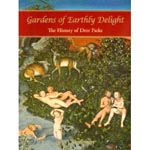Book Review: Gardens of Earthly delight: The history of Deer Parks
Tim Richardson applauds an always enjoyable and sometimes controversial history of a country-house essential


To order any of the books reviewed or any other book in print, at
discount prices* and with free p&p to UK addresses, telephone the Country Life Bookshop on Bookshop 0843 060 0023. Or send a cheque/postal order to the Country Life Bookshop, PO Box 60, Helston TR13 0TP * See individual reviews for CL Bookshop price.
Book Review: Gardens of Earthly delight: The history of Deer Parks
The deer park is one of those visions of medieval England that seem almost impossibly romantic as survivals nowadays. Whose heart does not leap at the-always somehow unexpected-sight of a herd of deer grazing in a park? Red deer are more ‘authentic' as the native species, but, since the Norman Conquest, fallow have been considered more beautiful ‘they love to form great aggregations, and a dense sea of exquisitely spotted deer murmuring and piping quietly amongst themselves can still dazzle us with sheer beauty'.
This is an accessible, wide-ranging and immensely enjoyable history by a deer veterinarian who gained a PhD in the subject at Cambridge and can convincingly quote from Italo Calvino, Gaston Bachelard and William Wordsworth. It is billed and presented as an international history, and there are short chapters on deer parks in China and Mughal India.
Its bulk and real value, however, is as a chronicle of the English deer park, with side-roads into Scotland and Continental Europe. Who, for example, knew about the widespread practice from the late 17th century of ‘water hunts', when deer would be driven into rivers, lakes and pools so they could be killed by huntsmen in boats? This was often combined with the erection of elaborate mock castle façades or triumphal arches, through the gateways of which the hunted animals were driven into the water for the entertainment of spectators.
The author notes that, in recent years, historians have begun dropping the ‘deer' from deer parks, to acknowledge the wide range of other activities that occurred within the pale-grazing of other livestock, timber production, pheasant coverts and so on, as well as less decorative estate industries such as quarrying, smelting, tanning, milling and charcoal burning. But Dr Fletcher makes the point that deer, as status symbols (their main role, he says), were always unquestionably considered the most important asset in any park, and persuasively argues that calling a deer park merely a park isn't good enough.
Sign up for the Country Life Newsletter
Exquisite houses, the beauty of Nature, and how to get the most from your life, straight to your inbox.
He also reminds us that the straight radial avenues of large formal landscape parks, eman-ating from a central patte d'oie, or ‘goose foot', are derived from the need for spectators and participants in deer hunts to be able to view the quarry and the hunting party from one central point, as they crossed the allées from one parcel of woodland to the next.
More controversial is his contention that the ancient wooded landscape of Britain in actuality resembled a kind of savannah, or open wood-pasture, because of the grazing habits of deer and other animals, which result in groves of trees. The New Forest represents the largest single survival of this habitat in West-ern Europe. It may prove difficult, however, to dislodge the average person's vision of pre-enclosure Britain as a kind of Robin Hood sylvan paradise.
Mention must also be made of the author's brand-new theory regarding the derivation of the term ha-ha, a perimeter ditch in an English park. It is usually said to be a phonetic rendering of the ‘A-ha!' exclamation (as in: ‘A-ha! A hidden ditch!'). No, says Dr Fletcher, citing his Dutch colleague Frans Vera, who tells him that the Flemish word for deer park, haga-as echoed in the names of The Hague in the Netherlands, Haga in Sweden and possibly Hagley in this country-is pronounced something like our ha-ha.
* Subscribe to Country Life and save 40%
Country Life is unlike any other magazine: the only glossy weekly on the newsstand and the only magazine that has been guest-edited by HRH The King not once, but twice. It is a celebration of modern rural life and all its diverse joys and pleasures — that was first published in Queen Victoria's Diamond Jubilee year. Our eclectic mixture of witty and informative content — from the most up-to-date property news and commentary and a coveted glimpse inside some of the UK's best houses and gardens, to gardening, the arts and interior design, written by experts in their field — still cannot be found in print or online, anywhere else.
-
 380 acres and 90 bedrooms on the £25m private island being sold by one of Britain's top music producers
380 acres and 90 bedrooms on the £25m private island being sold by one of Britain's top music producersStormzy, Rihanna and the Rolling Stones are just a part of the story at Osea Island, a dot on the map in the seas off Essex.
By Lotte Brundle
-
 'A delicious chance to step back in time and bask in the best of Britain': An insider's guide to The Season
'A delicious chance to step back in time and bask in the best of Britain': An insider's guide to The SeasonHere's how to navigate this summer's top events in style, from those who know best.
By Madeleine Silver